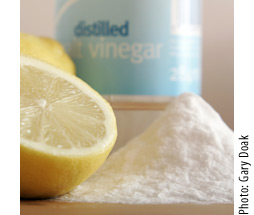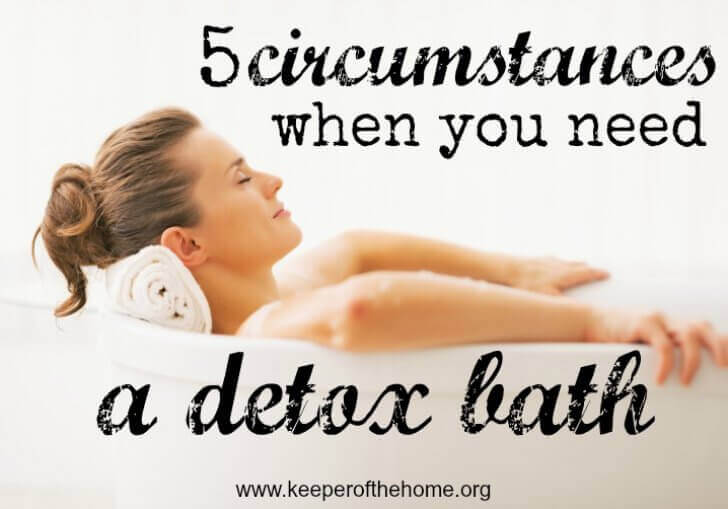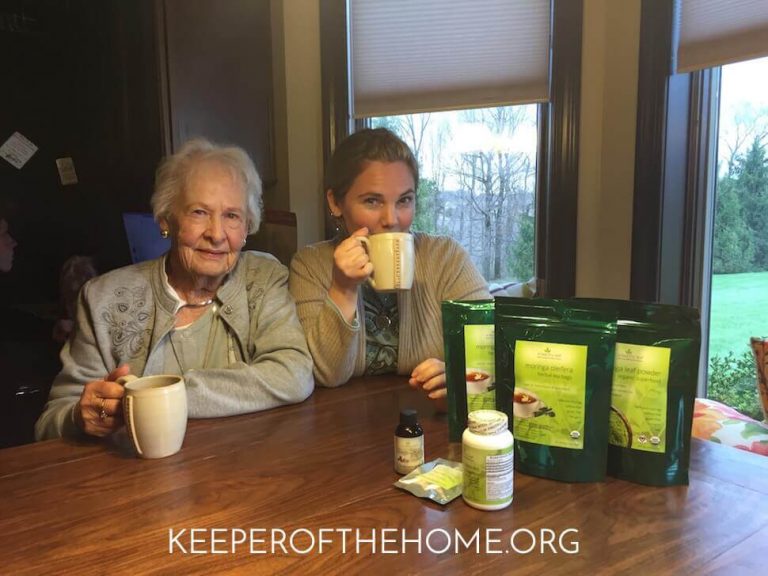Carefree Cleaning

Being a keeper at home is a special blessing that the Lord has assigned us women. We have the honor of not only maintaining our homes but also caring for the health of our families. It is with that thought in mind that I write this.
We all know that as mothers and wives we need to cook nutritious and satisfying meals. But does our duty in fostering good health end there? I believe that we need to pay special attention to what we clean with too. Many commonly used household cleaners are nothing more than harmful chemicals with a nice perfumey smell. But, there are an abundance of alternatives to chemical cleaners. One could buy some of the “natural” cleaners sold at many health food stores today, but why spend SO much money when many of the ingredients you need to make effective, safe, simple cleaners are already sitting in your cabinet? Here are just a few of the recipes I use and find most helpful!
My most used:
Best for cleaning bathrooms:
Kitchen Cleanser
Ingredients
- Baking soda
- Essential oil optional
Instructions
- Fill a plastic or stainless steel shaker (ex. large salt and pepper shakers) halfway with baking soda. Add 15 to 20 drops essential oil (try lemon). Stir. Add more baking soda until it reaches the top of the shaker. Secure the lid and shake to mix. To use, sprinkle on counters or in sinks, then wipe with a damp cloth or sponge. Rinse well. Don’t use too much or you’ll need to keep rinsing and wiping.
Other tips:
~Don’t buy expensive veggie and fruit washing sprays at the store. I keep a bottle of vinegar and a bottle of hydrogen peroxide under my sink. Spray veggies or fruit first with vinegar and then with peroxide. Rinse. It is quite satisfying to see all the germs and bacteria bubble away!
~Instead of buying scrubbing pads that need to be disinfected or thrown out all the time, save your bag next time you buy onions. Simply place your washcloth inside the bag and scrub. So easy!
Great tools to have:
~old toothbrushes
~cotton rags (keep those old socks!!)
~lots of spray bottles for homemade cleaning solutions
~a dutch rubber broom- while this is not a common cleaning item, I love mine. It is a long handled rubber floor squeegee with a short fingered rubber rake on the other side. I use it at least once a day. (www.euroshine.net)
~a small portable steam cleaner- again, not very common but this is a great non-toxic way of removing grease and grime from most surfaces.
~ the book Organic Housekeeping
by Ellen Sandbeck. I have this book highlighted to within an inch of it’s life! She has a wealth of information on how to keep your home healthy and clean.
I hope these tips help those of you who are seeking to make your family environment a little healthier. I no longer have to worry about my precious little ones getting under the sink, or if one of them decide licking the window would be a good idea (it happens!). It is truly carefree cleaning! God bless each of you as you seek to glorify His precious name.
Amanda is 26 years old. She and her husband, John, have been married for almost 6 years. They have three children Lilly (4), Luke (3) and Bradley (1), with their 4th little blessing due at the end of February. She feels blessed to have been called to be a keeper at home. Over the past couple years she’s been learning how to keep her family healthy, and realizing it stretches to all areas of life ( i.e. food, cleaning, education, spirituality). She feels she has a lot more to learn but loves sharing what she can! To get a glimpse into her life, visit mock-n-bird.blogspot.com
Other Related Posts You May Enjoy
- Back to the Basics: Frugal, Non-Toxic Green Cleaning
- Baby Steps: Going More Natural, One Cleaner at a Time
- Non-Toxic Cleaners You Can Make at Home
- Better, Cheaper, Safer 4-Way Soft-Scrubber
- Clean Your Shower or Bathtub Simply
- Natural and Eco-Friendly Laundry Soap Reviews: 5 Moms Test and Compare
- Non-Toxic Disinfectants
- Two Recipes for Odor Eliminating, Air Freshening Sprays!
- A Natural Stain Remover that Really Works!
- Charting the Way To Successful Stain Removal
- Price Comparisons on Homemade Cleaners
- The Stain Removal Trick that Saves Kids Clothes, Money, and My Sanity
- How to Get Set In Stains Out of (Almost) Everything




I switched to all homemade cleaners over a year ago, and love it! The Organic Housekeeping book was what did me in. 🙂 A good read for anyone who takes care of a home!
Thank you for posting these recipes. I am going to try them. I am also going to check out the book.
Have a blessed day.
BJ
Awesome tips Amanda!
What a plethora of information!! Thank you for all of these wonderful tips; I can’t wait to have my own home and try these out…thank you thank you thank you!!
jenifriend
Awesome post! I have been wanting to switch to “natural” cleansers, but was daunted by the price of store bought ones. This looks so easy!! Any suggestions for replacing dishwashing detergent?
Great post! There is so much helpful information here, and I am going to look into getting that book. Thank you!
That’s so funny you asked about dishwasher detergent, Jess! That’s the first thing I looked for when Amanda sent me the post! 🙂 Guess when you’re friends for 10 years, you start to think alike. Maybe together we can search and come up with an option, because that’s currently the most expensive portion of the natural store-bought cleaners that I use.
Thanks for a great post. I am using more and more natural/homemade cleaners and it’s good knowing everyone is safer and the house is just as clean. Thanks for the book idea, too. I will definitely be looking for it.
I have a healthy dishwasher recipe if you would like it…..I don’t have a blog but could send it to you…
Jessica
I have been wanting to go to more natural cleaners, but where do you find the castile soap, without having to order it online?
Jessica, yes please! I would love your dishwasher recipe! You can send it to my email at keeperofthehome (at) canada (dot) com. I’ll post it for everyone else. Thanks so much!
Theresa, I buy a brand of castille soap called Dr. Bronners. It’s available at most health food stores, either in their cleaning section or their beauty section. Some supplement stores may also carry it. Ask for it by name, as it’s quite popular.
What is castile soap? Where do you buy borax? Why is regular liquid soap okay to use when it has chemicals as well? What liquid soap do you use? I guess I have quesitons. :o)
I have heard about people using hydrogen peroxide. Where do you get it? Is it just called that? I use powdered hydrogen peroxide for laundry stains (its called safe bleach) so I am sort of confused.
Does using vinegar and hydrogen peroxide also remove surface pesticide residues from fruit and veggies? Or just bacteria?
Thank you so much for this post! One of my new year’s goals was to research safer, made at home cleaners. I’m printing this list now.
You can get Borax and Dr. Bronner’s liquid castille soap at Target. The Borax is in with the bleach, and the liquid castille soap is with health and beauty supplies.
Do you notice a lingering vinegar smell when you use these recipes? It doesn’t bother me so much, but my husband absolutely, passionately hates it.
i tried to check out your blog but it didn’t connect.
I thought I’d take a minute to address some of the question that are floating around in the responses. 🙂 First, what is castile soap? Castile soap isn’t a brand but a type of soap made exclusively from vegetable oil rather than animal fat or synthetic substances.The simple nature of the soap means a lesser enviromental impact due to reduced waste stream during manufacture and also faster biodegradability. Second, hydrogen peroxide? I actually had never heard of powdered hydrogen peroxide! Sorry for the confusion! The peroxide that I am speaking of is a clear liquid sold in an opaque container usually found in the pharmacy section. Check by where they sell the alcohol and other first aid items. Also, there was a question about whether the vinegar and peroxide would remove the residual pesticides. Of course, it’s always best to buy organic. (P.S. check my website today for a way to stretch your organic budget) But sometimes our pocket books won’t always allow that! You could always scrub your produce down with a little baking soda, then rinse. Third, a lingering vinegar smell?? With the cleaners that are mainly vinegar (i.e. floor cleaner, window cleaner) I would say yes, there is a slight vinegar smell BUT it only lasts a little while. A hour or two after you’ve cleaned the smell goes away and all that’s left is the smell of…well…clean. (And I’m not talking about the chemical “perfume” smell most of us associate clean with!) 🙂 Lastly, my website! http://www.mock.n.bird.blogspot.com I accidentally put a space between the www. and the mock. Oops! I hope that was all the questions! Thanks for reading everyone! I’m SO glad those recipes were helpful!
Thanks for answering my questions! I agree it IS best to buy organic and we do what we can (especially the ones on the worst list) but we often can’t do as much as we want. Those are great recipes though, I may have to try some to replace my natural store-bought cleaners that I use already.
I see Amanda has joined in to answer some questions- thanks Amanda! 🙂
As well, her link has been fixed in the post now. Sorry I didn’t realize before that it wasn’t working, but now you can all go and visit Amanda’s lovely blog!
Great post and great recipes – thank you for the guest-post Amanda!
And thank you especially for the fruit/veggie wash “recipe”! I’ll have to try it! I’ve been meaning to try the vinegar plus hydrogen peroxide cleaning process anyway, but didn’t know it’d be safe on foods.
Best,
Sarah
Hi! Did you get the dishwasher recipe I sent over yesterday?
Jessica O.
Thanks for sharing the recipes, I would like to get out of the habit of using commercial cleaners and using something less toxic. I wanted to ask however what kind of portable steam cleaner you use. We recently used one that had great reviews but did not cut the grease or dirt at all, it didn’t even do a good job on the grout between the tiles, which is what we mainly wanted it for.
I know this post was a while ago, but I am hoping someone will read my comment/question. Can someone tell me where to get distilled white vinegar? I have only seen pure white vinegar in the stores here. Is it a Canada vs US thing?
Jess, my understanding is that the main difference is the strength of the acidity. Distilled vinegar is a bit higher in acidity than the regular white vinegar (around 5% as compared to 4%). It’s not really suitable for eating, but great for cleaning.
I don’t know where to find it, though I’m sure it does exist in Canada. I just use the huge jugs of white vinegar from Costco for my cleaning and they work pretty well. If you do find distilled, let me know! 🙂
This was such a helpful post. I found all of the ingredients that I needed in bulk at a local store and made most of the cleaners! I’m linking to this post on my blog so that hopefully some of my friends can use them too. I have so enjoyed reading your blog, thanks for all of the info.
Peroxide is used to oxygenate, clean, even lighten things (like hair! It’s in a lot of hair dyes and stuff like Sun-In. You can put it directly on your hair and go out in the sun. It will lighten your hair but it also dries it out something terrible so I don’t recommend;). You can use peroxide on cuts to get them cleaned and add oxygen to them (inhibits some of the baddie germs) but it also kind of lightens your skin just a bit temporarily. Peroxide can be found with baking soda in toothpastes designed to whiten teeth (since it’s a bleach) and it can be used as mouthwash (I think you need to dilute it though – always read the bottle) and to help get wax out of your ears. You can sanitize cutting boards with it, too. I have always found it on the bottom shelf in the area with Band Aids and first aid stuff, usually in dark brown plastic bottles. It’s super cheap, too! You can get a nice sized bottle for less than $1.
http://www.snopes.com/medical/homecure/peroxide.asp
Very nice and informative post. I really enjoyed reading it. Great work.
Great cleaning methods. Every cleaning company should definitely offer them all!
Thanks!
There is so much helpful information here, and I am going to look into getting that book. Thanks !